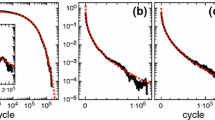Abstract
Theoretical predictions for the dynamic moduli of long, linear, flexible, monodisperse polymers are summarized and compared with experimental observations. Surprisingly, the predicted 1/2 power scaling of the long-time modes of the relaxation spectrum is not found in the experiments. Instead, scaling with a power of about 1/4 extends all the way up to the longest relaxation times near τ/τ max = 1. This is expressed in the empirical relaxation time spectrum of Baumgaertel-Schausberger-Winter, denoted as “BSW spectrum,” and justifies a closer look at the properties of the BSW spectrum. Working with the BSW spectrum, however, is made difficult by the fact that hypergeometric functions occur naturally in BSW-based rheological material functions. BSW provides no explicit solutions for the dynamic moduli, G ′(ω), G ″(ω), or the relaxation modulus G(t). To overcome this problem, close approximations of simple analytical form are shown for these moduli. With these approximations, analysis of linear viscoelastic data allows the direct determination of BSW parameters.





Similar content being viewed by others
References
Abdel-Goad M, Pyckhout-Hintzen W, Kahle S, Allgaier J, Richter D, Fetters LJ (2004) Rheological properties of 1,4-polyisoprene over a large molecular weight range. Macromolecules 37:8135–8144
Abramowitz M, Stegun IA (1984) Pocketbook of mathematical functions. Verlag Harri Deutsch, Frankfurt/Main
Baumgärtel M, Schausberger A, Winter HH (1990) The relaxation of polymers with linear flexible chains of uniform length. Rheol Acta 29:400–408
Baumgärtel M, Derosa ME, Machado J, Masse M, Winter HH (1992) The relaxation time spectrum of nearly monodisperse polybutadiene melts. Rheol Acta 31:75–82
Carri GA, Winter HH (1997) Mapping of the relaxation patterns of polymer melts with linear flexible molecules of uniform length. Rheol Acta 36:330–344
Doi M (1974) Molecular theory of the viscoelastic properties of concentrated polymer solutions. Chem Phys Lett 26:269–272
Doi M (1981) Explanation for the 3.4 power law of viscosity of polymeric liquids on the basis of the tube model. J Polym Sci Polym Lett Ed 19:265
Doi M (1983) Explanation of the 3.4-power law for viscosity of polymeric liquids on the basis of the tube model. J Polym Sci Polym Phys 21:667–684
Ferry JD (1980) Viscoelastic properties of polymers. Wiley, New York
Garcia-Franco CA, Herrington BA, Lohse DJ (2005) On the rheology of ethylene-octene copolymers. Rheol Acta 44:591
Jackson JK, De Rosa ME, Winter HH (1994) Molecular weight dependence of relaxation time spectra for the entanglement and flow behavior of monodisperse linear flexible polymers. Macromolecules 27:2426–2431
Milner ST, McLeish TCB (1998) Reptation and contour-length fluctuations in melts of linear polymers. Phys Rev Lett 81:725
Onogi S, Masuda T, Kitagawa K (1970) Rheological properties of anionic polystyrenes. I. Dynamic viscoelasticity of narrow distribution polystyrenes. Macromolecules 3:109
Schausberger A, Schindlauer G, Janeschitz-Kriegl H (1985) Rheol Acta 24:220
Acknowledgements
HHW acknowledges the support from DFG by SFB428 and support from MRSEC NSF DMR0213695. The authors thank W. Pyckhout-Hintzen for the sharing his PI data.
Author information
Authors and Affiliations
Corresponding author
Appendices
Appendix 1: Asymptotes to the dynamic moduli
The approximate solution has to satisfy Eqs. 20 and 21 at low and at high frequencies, (ωτ max < <1) and (ωτ max > >1). The low frequency asymptotes of the dynamic moduli of BSW are
The low-frequency asymptotes intersect at (see Fig. 5)
The corresponding high frequency asymptotes are
Appendix 2: Incomplete gamma function for G(t) and approximate solution
For completeness, we present the approximation of the relaxation function obtained for BSW spectrum. Again, we start out with the expression of Carri and Winter (1997). The BSW-spectrum solution for Eq. 2,
includes an incomplete Gamma function that can be replaced by a suitable approximation. The result is a polynomial expression multiplied by an exponential decay:
An optimized fit is achieved with α = 1.23 and β = 0.18. The approximation is chosen such that the equation is an exact solution for the short time and the long time asymptotes (while neglecting the glass transition as stated in the beginning). These two limits are
Appendix 3: Same other interesting properties of BSW related moduli
The maximum of the loss modulus is a distinct data point from dynamic mechanical experiments. ω max is the particular frequency for which \(G^{\prime\prime}=G_{\max }^{\prime\prime} =G^{\prime\prime}(\omega_{\rm max})\). When predicted with BSW, \(G_{\max }^{\prime\prime} \) posses properties that resemble the Maxwell model:
with x max = ω max τ max. Although this equation is of Maxwellian structure, the Maxwell result is not recovered because, for the same material parameters, ω max is different for the Maxwell and the BSW spectra. Equation 32 can be derived from the integral equation for \(G_{\max }^{\prime\prime} \),
together with the defining equation for the abscissa. The condition \({{d}G^{\prime\prime}} \mathord{\!\left/\! {\vphantom {{{d}G^{\prime\prime}} {\left. {{d}\omega } \right|_{\omega =\omega \max } }}} \right. \kern-\nulldelimiterspace} {\left. {{d}\omega } \right|_{\omega =\omega \max } }=0\) results in
The solution of Eq. 34 results in the value for x max. For this purpose, we substitute the integral by the corresponding hypergeometric function and then transform the equation to receive the following result:
Again, we approximate the hypergeometric function by a simpler function and arrive at
which leads to an explicit expression for x max:
Together with Eq. 32, we obtain the final result:
or
that relates the value of the plateau modulus to the maximal value of the G ″ for a known relaxation exponent n e.
Rights and permissions
About this article
Cite this article
Friedrich, C., Waizenegger, W. & Winter, H.H. Relaxation patterns of long, linear, flexible, monodisperse polymers: BSW spectrum revisited. Rheol Acta 47, 909–916 (2008). https://doi.org/10.1007/s00397-008-0280-5
Received:
Revised:
Accepted:
Published:
Issue Date:
DOI: https://doi.org/10.1007/s00397-008-0280-5



